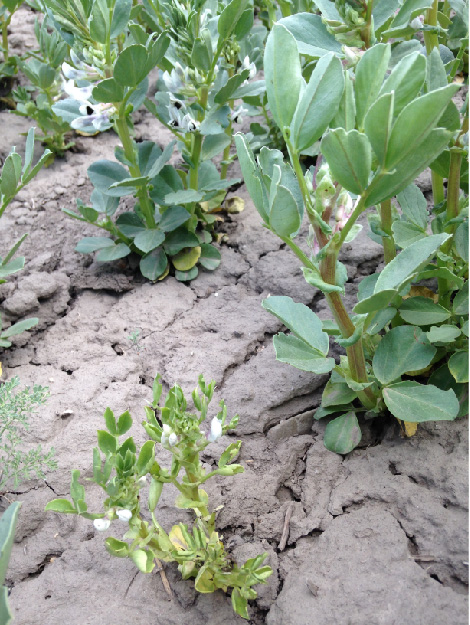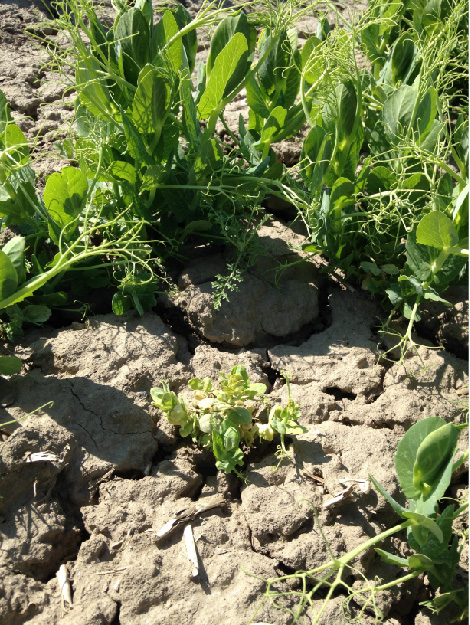Pea necrotic yellow dwarf virus
Pea necrotic yellow dwarf virus
Profile
Pea necrotic yellow dwarf virus (PNYDV) belongs to the nanoviruses and infects legumes, such as peas, field beans, vetches, lentils and chickpeas. PNYDV is transmitted by aphids, mainly the green pea aphid and black bean aphid. If infection occurs early in plant development, it can result in enormous yield losses and even total failure.
Biology
Nanoviruses are very small viruses relative to other viruses that cause plant diseases, and their genetic information consists of DNA. The three nanovirus species detected so far in Central Europe show genetically large differences compared to the previously known nanoviruses. The nanovirus species mainly detected in Austria is the so-called Pea necrotic yellow dwarf virus (PNYDV).
Damage symptoms
Early infestation with PNYDV is manifested by stunted plants with often significantly reduced leaves and shortened shoot axes (internodes), as well as reduced root and nodule formation. Leaves turn yellow and are sometimes curled upward, and shoot tips may die. On some crops (lentil, chickpea), red discoloration can also be observed in some cases. Flower and pod set is low, and grain formation is poor. In field beans, late-infested plants can reach normal growth heights and pod set, but are strongly chlorotic. So-called infestation nests, which are roundish areas in the stands with infected, yellow and dwarfed plants, are typical. In field beans, distressed plants with black stems are also found in the infestation nests.


Host plants
In four-year trials, natural infestation with PNYDV was detected in Austria on pea (summer and winter field pea, green pea, pelucca), field bean (summer and winter field bean), lentil (summer and winter lentil), chickpea, vetch, Pannonian vetch (Vicia pannonica), forage vetch(V. sativa), and rough vetch(V. hirsuta).
Soybean, alfalfa, red and white clover, or Phaseolus beans are not considered host plants.
Distribution
Nanoviruses were first known in warmer regions, such as North and East Africa, the Middle East, Asia and Australia. There, they cause massive yield losses in various legumes, such as field beans, lentils or chickpeas, at periodic intervals. In 2009, PNYDV was detected for the first time in pea stands in Germany, and in 2010 for the first time in Austria.
Since 2013, typical symptoms, such as upsetting and yellowing in peas and field beans, have been repeatedly detected in Austria, and PNYDV has been detected. An almost area-wide, diagnostically proven infestation with PNYDV in peas and field beans occurred for the first time in 2016, confirming that the spread of this virus and also its danger for domestic legume cultivation is high. So far, PNYDV has been detected not only in Germany and Austria, but also in Denmark, the Netherlands, the Czech Republic, Hungary and Serbia.
Propagation and transmission
Nanoviruses are only transmitted by aphids as vectors. The green pea aphid and the black bean aphid are the most important vectors. Nanoviruses cannot be transmitted mechanically (via touch) or via the seed.
Prevention and control
- If plants are infected with nanoviruses, as with all plant pathogenic viruses, no curative (=healing) measures are possible.
- Since PNYDV is transmitted neither mechanically nor via seed, but only via aphids, the only control option is indirect and consists of preventive control of the aphids - see also the warning service of the chambers of agriculture.
- In summer plantings, it is advisable to plant varieties as early as possible so that the plants are as developed as possible when infected with the virus. In winter tillage, late cultivation is advisable to keep infections low in the fall.
- Studies have shown that mixed cropping (such as field bean/oats, grain pea/barley) also reduces aphid infestation on legumes.
- Legume species that are hardy and host plants for PNYDV provide the virus reservoir for infections at the beginning of a new growing season. These legume species should either be avoided in pea and arable regions, or turned over in time if they have not frozen off in the spring.
Specialist information
In research projects, we deal with the epidemiology of PNYDV and with possible measures and control strategies.
We have been supporting the Chamber of Agriculture's warning service with aphid monitoring and virus testing since 2017.
In the DaFNE project "NANOVIR " (2018 to 2020), the natural host plants of PNYDV and the role of different aphid vectors in Austria were determined. Furthermore, different spraying agent variants and mixed cultivation in organic field beans were investigated.
The CORNET project "SPITFIRE " (Dec. 2021 to 2024, scientific lead: Julius Kühn Institute Braunschweig) is looking for resistance to PNYDV in peas.
The EIP-AGRI project (May 2019 to April 2022) aims to implement a practical and environmentally friendly solution to the problem of aphid infestation and the associated risk of infection with nanoviruses in field beans.
Last updated: 03.10.2025
automatically translated